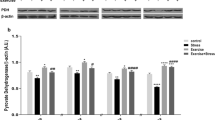We explored the mechanism underlying the improvement of tolerance to exercise-heat stress through physical training at a moderate temperature. Rats were randomly divided into an aerobic exercise (AE) group and a control (C) group. Rats in the former group were subjected during 5 weeks for AE in a cool environment (20°C). The oxidative damage level in the brain to AE rats after both 1-h-long heat exposure and exhaustive exercise in heat and the rate of core temperature rise were lower than those in the control (P < 0.05). The expression level of HSP70 in the motor cortex and the exhaustion time in group AE were found to be significantly greater compared to those in group C (P < 0.05). Our results indicate that the enhanced expression of HSP70 may be an important factor for physical training in a cool environment, and this factor improves tolerance to exercise-heat stress.
Similar content being viewed by others
References
J. González-Alonso, C. Teller, S. L. Andersen, et al., “Influence of body temperature on the development of fatigue during prolonged exercise in the heat,” J. Appl. Physiol. (1985), 86, No. 3, 1032–1039 (1999).
L. Nybo and B. Nielsen, “Hyperthermia and central fatigue during prolonged exercise in humans,” J. Appl. Physiol. (1985), 91, No. 3, 1055–1060 (2001).
Y. Aoyagi, T. M. McLellan, and R. J. Shephard, “Interactions of physical training and heat acclimation,” Sports Med., 23, No. 3, 173–210 (1997).
S. S. Cheung and T. M. McLellan, “Influence of short-term aerobic training and hydration status on tolerance during uncompensable heat stress,” Eur. J. Appl. Physiol. Occup. Physiol., 78, No. 1, 50–58 (1998).
K. B. Pandolf, “Effects of physical training and cardiorespiratory physical fitness on exercise-heat tolerance: recent observations,” Med. Sci. Sports, 11, No. 1, 60–65 (1978).
S. Chalmers, A. Esterman, R. Eston, et al., “Short-term heat acclimation training improves physical performance: a systematic review and exploration of physiological adaptations and application for team sports,” Sports Med., 44, No. 7, 971–988 (2014).
R. Tucker, L. Rauch, Y. X. R. Harley, and T. D. Noakes, “Impaired exercise performance in the heat is associated with an anticipatory reduction in skeletal muscle recruitment,” Pflugers Arch., 448, No. 4, 422–430 (2004).
D. M. Bailey, K. A. Evans, J. McEneny, et al., “Exercise-induced oxidative–nitrosative stress is associated with impaired dynamic cerebral autoregulation and blood–brain barrier leakage,” Exp. Physiol., 96, No. 11, 1196–1207 (2011).
U. Wisløff, J. Helgerud, O. J. Kemi, and O. Ellingsen, “Intensity-controlled treadmill running in rats: Vo2max and cardiac hypertrophy,” Am. J. Physiol. Heart Circ. Physiol., 280, No. 3, H1301–H1310 (2001).
D. L. Wang, X. L. Liu, and D. C. Qiao, “Modulatory effect of subthalamic nucleus on the development of fatigue during exhausting exercise: An in vivo electrophysiological and microdialysis study in rats,” J. Sport. Sci. Med., 11, No. 2, 286–293 (2012).
G. Paxinos and C. Watson, The Rat Brain in Stereotaxic Coordinates, San Diego (1997).
E. Shohami, E. Beit-Yannai, M. Horowitz, and R. Kohen, “Oxidative stress in closed-head injury: brain antioxidant capacity as an indicator of functional outcome,” J. Cereb. Blood Flow Metab., 17, No. 10, 1007–1019 (1997).
P. H. Evans, “Free radicals in brain metabolism and pathology,” Br. Med. Bull., 49, No. 3, 577–587 (1993).
R. J. Reiter, “Oxidative processes and antioxidative defense mechanisms in the aging brain,” FASEB J., 9, No. 7, 526–533(1995).
E. A. Kiyatkin and H. S. Sharma, “Permeability of the blood–brain barrier depends on brain temperature,” Neuroscience, 161, No. 3, 926–939 (2009).
P. Watson, S. M. Shirreffs, and R. J. Maughan, “Blood-brain barrier integrity may be threatened by exercise in a warm environment,” Am. J. Physiol. Regul. Integr. Comp. Physiol., 288, No. 6, R1689–R1694 (2005).
S. R. McAnulty, L. McAnulty, D. D. Pascoe, et al., “Hyperthermia increases exercise-induced oxidative stress,” Int. J. Sports Med., 26, No. 3, 188–192 (2005).
B. Nielsen and L. Nybo, “Cerebral changes during exercise in the heat,” Sports Med., 33, No. 1, 1–11 (2003).
H. Y. Kil, J. Zhang, and C. A. Piantadosi, “Brain temperature alters hydroxyl radical production during cerebral ischemia/reperfusion in rats,” J. Cereb. Blood Flow Metab., 16, No. 1, 100–106 (1996).
G. I. Lancaster, K. Møller, B. Nielsen, et al., “Exercise induces the release of heat shock protein 72 from the human brain in vivo,” Cell Stress Chaperones, 9, No. 3, 276–280 (2004).
S. Lindquist, “The heat-shock response,” Annu. Rev. Biochem., 55, 1151–1191 (1986).
Z. Radak, A. W. Taylor, H. Ohno, and S. Goto, “Adaptation to exercise-induced oxidative stress: from muscle to brain,” Exerc. Immunol. Rev., 7, 90–107(2001).
B. Kalmar and L. Greensmith, “Induction of heat shock proteins for protection against oxidative stress,” Adv. Drug Deliv. Rev., 61, No. 4, 310–318 (2009).
Author information
Authors and Affiliations
Corresponding author
Rights and permissions
About this article
Cite this article
Wang, D., Ripley-Gonzalez, J.W. & Hu, Y. Aerobic Physical Training Protects the Rat Brain Against Exercise-Heat Related Oxidative Damage through the Increased Expression of HSP70. Neurophysiology 51, 66–71 (2019). https://doi.org/10.1007/s11062-019-09794-9
Received:
Published:
Issue Date:
DOI: https://doi.org/10.1007/s11062-019-09794-9




